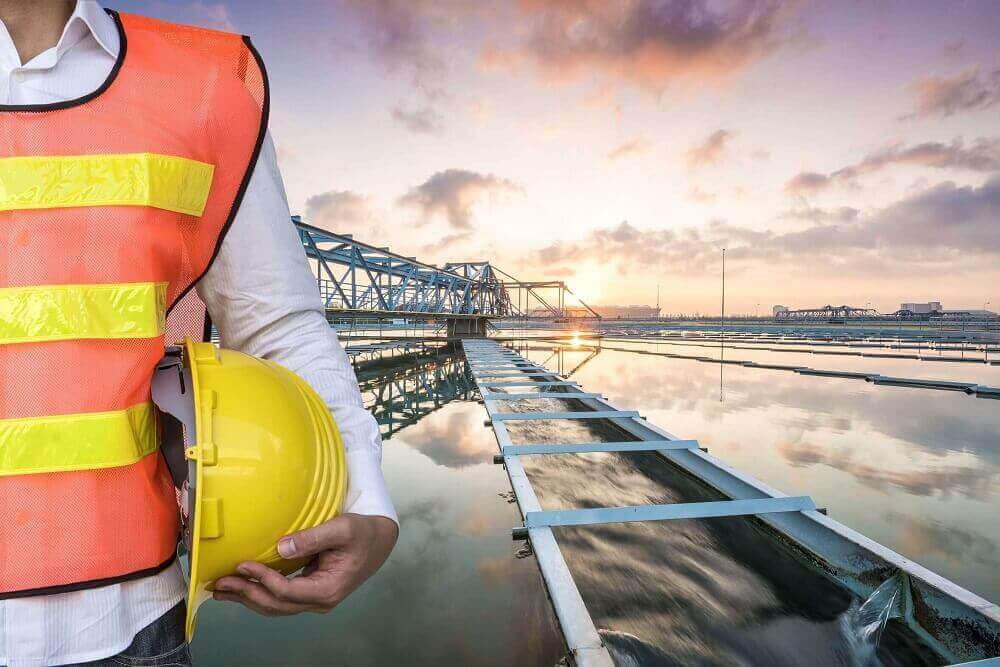Wastewater and sewage processing is an expensive, but important undertaking for every community. Maintaining your wastewater treatment infrastructure, particularly concrete and metal water processing tanks, is essential to keeping these facilities operational for many years without interruption.
One of the best ways to protect your water treatment facility is to apply advanced polyurea protective coatings during the construction phase as a pre-emptive measure as polyurea reinforces the strength of the structure and prevents future damages. Polyurea coating systems are also an excellent restoration option and work well as a reparative solution for minor or major structural damages such as cracks or leaks.

Keep reading to learn more about why polyurea is the superior solution for protecting wastewater infrastructure and preventing future damages.
What Are Water Treatment Facilities?
Water treatment facilities or plants, also known as sewage treatment centers, are responsible for purifying and removing harmful contaminants from the water supply of their assigned municipality or local community.
Municipal wastewater mainly consists of household sewage, but it can also contain local industrial wastewater as well.
Various chemical treatment processes are used to remove contaminants and toxins from the municipality’s main water supply. The primary goal of wastewater treatment facilities is to ensure the treated water is safe enough to release back into the local environment without causing biological safety hazards or disrupting the local ecosystem.
What Problems Do Water Treatment Facilities Face?
Water treatment facilities face a number of infrastructure-based problems and damages that must be immediately addressed. Here are some common challenges that can have a significant negative impact on the water treatment process.
Extensive Damage
Both concrete and metal tanks are susceptible to corrosion over time. Long-term concrete cracking and deterioration is a serious and potentially expensive problem in the water treatment industry. Aging concrete, in particular, is more susceptible to cracking due to the constant exposure to and direct contact with a variety of harsh chemicals that are used to pre-treat and treat wastewater deposits.
Other noteworthy causes of concrete cracking in water treatment facilities include:
- Damages from natural disasters such as hurricanes, tornadoes, and earthquakes (tectonic plate movement)
- Drastic daily and seasonal temperature or climate changes (extreme cold or heat caused by freeze-thaw cycles) that cause the concrete to contract and expand
Another major cause of corrosion for both concrete and metal tanks and/or pipes is Microbiologically Induced Corrosion (MIC). This occurs when bacteria, also known as “concrete-eating bacteria,” oxidizes sulfur from hydrogen sulfide (sewer gas) and produces sulfuric acid as a by-product. This is a major problem because sulfuric acid is highly corrosive and can cause significant damage to concrete, steel, and non-ferrous metals, especially when heated up due to warmer temperatures in the summer. Concrete and various metals will then lose their shape and will be unable to support loads and function correctly.
Additionally, frequent direct contact and exposure to harsh chemicals that are used to treat wastewater and sewage combined with the anaerobic organisms that are found in sewer systems can quickly deteriorate concrete and metal infrastructure in water processing facilities.
Financial Repercussions
One of the biggest challenges wastewater facilities face is managing damages caused by the aforementioned factors. Minor cracks and leaks can quickly escalate and make the construction and facility maintenance process a lot harder, not to mention the financial repercussions of damages to the infrastructure.
Government bodies, such as the Environmental Protection Agency (EPA) and Environment Canada, can issue large fines for damaged wastewater facility infrastructure that allow exfiltration of wastewater and infiltration of groundwater. Prolonged and neglected groundwater infiltration can cause further erosion in the concrete infrastructure and make for more sizeable repair and maintenance costs.
Ineffective Concrete Repair Methods
As a result of the continuous exposure to all of the previously mentioned elements, cement coatings typically don’t last more than a few years, which means infrastructure repair and maintenance costs can quickly pile up.
Traditionally, cementitious coatings have been used to repair concrete erosion and cracking at wastewater facilities. But this method has proven to be ineffective and more costly in the long run due to the constant need for repairs.
Polyurethane and epoxy coatings have also been used to protect concrete and metal wastewater tanks. However, these materials don’t provide the same level of chemical resistance, crack bridging ability, flexibility/elongation, and abrasion resistance that polyurea does. Polyurea coatings last significantly longer than these other coatings and have much quicker set times allowing for faster return to service.
Why Polyurea Protective and Waterproofing Systems Are the Right Solution
Polyurea coatings and linings are an excellent protective and rehabilitative solution to this problem. As the most durable, corrosion-resistant and chemically-resistant waterproofing coatings on the market, polyureas have the unique capability to solidly seal cracks, increase long-term wastewater management functionality, and prolong the lifespan of the repaired structure by up to a whopping 400%. This can help lower municipal spending on wastewater facilities and allocate funds toward other important community initiatives while maintaining a clean and drinkable water supply.
What Are the Benefits of Polyurea Coatings?
For water treatment plants, polyurea has greater elongation and chemical resistance than other coating materials like polyurethane and epoxies. Polyurea can significantly increase the lifespan of cement that is consistently exposed to abrasive chemicals like hydrogen sulfide and sulfuric acid. These chemicals cause severe breakdown of the concrete mixture compounds over long periods of time.
Other benefits of polyurea protective coatings include:
- Unmatched impermeability, which makes polyurea extremely waterproof and prevents wastewater exfiltration and groundwater infiltration throughout the facilities
- Polyurea coatings can be applied as a protective coating during the wastewater infrastructure construction or restoration process
- It can also be used as a rehabilitative measure if damages occur down the line
- Polyurea’s ability to set quickly (six to 30 seconds to set/dry to the touch and 24 hours to fully cure) minimizes the wastewater facility’s downtime and ensures operations can resume in as little time as possible.
As long as proper facility maintenance is administered on a regular basis, then polyurea coatings should last for decades without fail as opposed to just a few years.
Another advantage of advanced polyurea coatings is that they not only withstand extreme weather conditions and temperatures for long periods of time, but they can also be applied in virtually any kind of climate.
Advanced polyurea coatings have the durability and flexibility to overcome many years of freeze-thaw cycles and climate variations. This leads to the next point.
In the long run, polyurea for wastewater tanks can save taxpayers and wastewater facility management teams a significant amount of money in infrastructure maintenance, repair, and replacement fees.
Why Use Our Polyurea Coating Products?
IMC Distributors is the exclusive provider of the ISOMAT brand of products in Canada. Our polyurea products meet a wide variety of ASTM and EN certifications and we are continually testing to achieve further certifications.
All of our polyurea coatings are 100% solids and don’t contain any solvents or VOCs, making them an environmentally friendly coating. For wastewater management facilities, we recommend using ISOMAT PUA 2230, which is two-component, highly resistant, hot spray-applied pure polyurea membrane.
Our polyurea coating products are certified to last a minimum of 30 years even in severe weather conditions. To learn more about our products or to place an order, contact us today.
 Karli Logan is the Owner and President of IMC Distributors which is the exclusive partner of Nukote Coating Systems in Canada. With a B.Sc and M.Sc, as well as a demonstrated history of working across a number of industries, she has a passion to drive significant gains and benefits for IMC’s clients.
Karli Logan is the Owner and President of IMC Distributors which is the exclusive partner of Nukote Coating Systems in Canada. With a B.Sc and M.Sc, as well as a demonstrated history of working across a number of industries, she has a passion to drive significant gains and benefits for IMC’s clients.